SMA Extension Cable: Length, Loss & Buying Guide
Sep 17,2025
Will a right-angle or bulkhead SMA fix your mechanical limits?
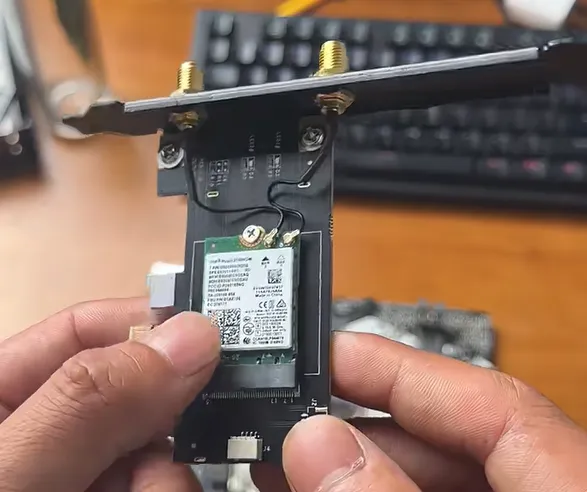
This image illustrates the primary use case for a 90-degree SMA connector. It shows how the angled design allows the cable to be routed away from obstacles like heat sinks or enclosure walls, thereby reducing strain on the connector soldered to a PCB and preventing mechanical failure. The context warns that while beneficial mechanically, such elbows introduce a small amount of additional signal loss (~0.1-0.2 dB).
Every enclosure has its quirks. You plan for a straight SMA extension cable, only to find it colliding with a heat sink or pressed against the wall. In such cases, a right-angle SMA cable—often sold as a 90-degree SMA extension—becomes the practical choice. By changing the path, it relieves stress and protects delicate jacks in compact housings.
But nothing is free in RF design. Each elbow adds around 0.1–0.2 dB of loss at microwave bands. That sounds small, yet in a finely tuned GPS or Wi-Fi system it can push your 50 ohm coax cable chain close to its limit. Many field installers have seen range dip or noise rise simply from a poor-quality elbow.
So when do you go straight, and when angled? If space allows, stick with straight—it keeps attenuation minimal. But in handheld radios, IoT gateways, or small routers, right-angle connectors prevent broken jacks from forced bends. A quick buyer’s tip: always check the VSWR rating of elbows. Quality parts—like those in TEJTE’s RF adapter cable range—stay under 1.25 up to 6 GHz, meaning you gain clearance without sacrificing performance.
Panel constraints and sealing with SMA bulkhead / IP67 bulkhead
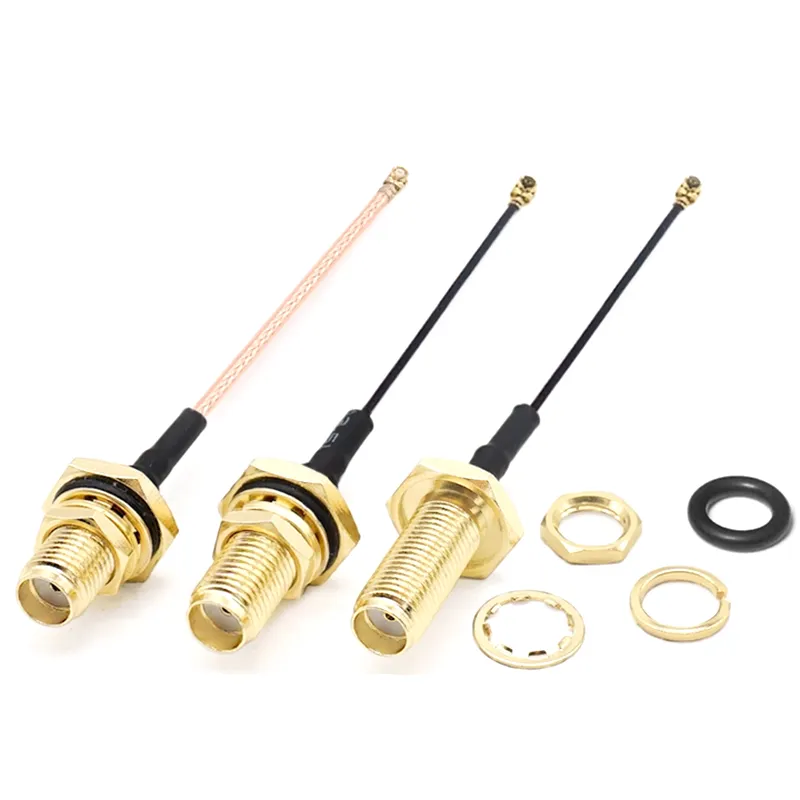
This image depicts the installation of an SMA bulkhead connector, highlighting its function in creating a robust and impedance-stable interface through an enclosure panel. It is secured with a nut and often features an O-ring for sealing, making it ideal for professional applications and essential for outdoor or harsh environments where IP67-rated versions (mentioned in the text) are used to prevent moisture ingress and premature failure.
Bulkhead SMAs solve another headache: bringing RF ports cleanly through a panel. Instead of squeezing a loose jumper through a hole, a bulkhead SMA connector threads in with a nut, often sealed by an O-ring. This design keeps impedance stable across the SMA male to female extension cable path and gives a more professional finish.
For outdoor runs, an IP67 bulkhead SMA is worth the spend. Its gasket blocks water, which matters for rooftop Wi-Fi, vehicle GPS antennas, and even small LTE base stations. In practice, poor sealing is one of the leading causes of premature cable failure. Many technicians add a wrap of sealant or tape for extra insurance. For more on outdoor loss and protection, see TEJTE’s coaxial cable guide.
Do you need SMA male-to-female or male-to-male today?
Connector gender isn’t just a label—it decides whether your system comes alive or sits silent. The most common setup in networking and RF testing is the SMA male to female extension cable. Routers and access points usually ship with female SMA jacks, while antennas terminate in male plugs. Extending the chain with a male-to-female cable preserves that pairing and avoids compatibility issues. For most buyers, this is the safe and reliable choice.
But there are times when SMA male-to-male extension cables are the better fit. Think of bench testing, where two instruments both present female ports. Here, a male-to-male acts as a bridge, but it should be kept short to reduce torque and strain. Letting a rigid coupler hang freely can crack delicate device jacks—a costly mistake. TEJTE’s RF adapter cable lineup includes both genders, available in RG316 for short flexible runs or LMR-200 when lower loss is critical.
Router/AP installs: male-to-female vs bridge-style male-to-male
Avoiding torque stress on device jacks with short pigtails
Will SMA or RP-SMA match your device ports?
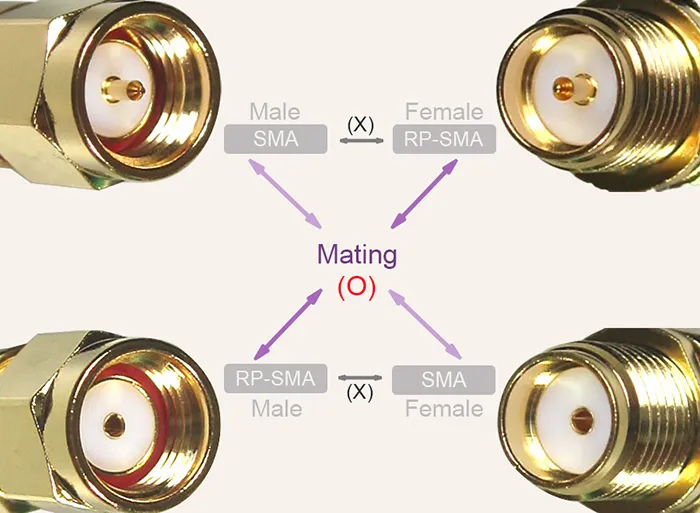
This is a crucial reference diagram that clearly illustrates the polarity difference between standard SMA and Reverse Polarity SMA (RP-SMA) connectors. It visually demonstrates that in RP-SMA, the gender of the center conductor is reversed compared to standard SMA—a common point of confusion that can lead to incompatible connections, especially in Wi-Fi equipment. The document emphasizes using this visual check to prevent procurement errors.
How to tell RP-SMA from SMA in 10 seconds
Here’s the quick field trick: hold the connector toward a light source.
- If you see a pin inside, that’s an SMA male.
- If you see a hole, that’s an RP-SMA male.
Reverse the logic for female ends. This tiny detail determines whether your Wi-Fi antenna locks in firmly or spins uselessly. For a deeper walkthrough with visuals, TEJTE’s SMA connector guide explains polarity and gender side by side.
Wi-Fi/router cases: wifi antenna extension cable / router antenna cable
In consumer networking, most routers use RP-SMA female ports. That means your rp-sma extension cable needs to be male on one side and female on the other to extend properly. Get this wrong, and the antenna won’t seat at all. For outdoor enclosures, RP-SMA bulkheads are often used to pass through the wall, then linked to an internal U.FL pigtail.
Professional RF instruments and ham radios, on the other hand, tend to use true SMA connectors. This is why many buyers searching for a “router antenna cable” end up disappointed when parts don’t fit. One missed “RP” in the spec sheet can derail an entire install. The safest approach is always to double-check port polarity before procurement, and when in doubt, reference TEJTE’s SMA vs RP-SMA explainer.
Which jacket, shielding and bend radius fit your enclosure?
When RG174 is flexible enough and when it isn’t
What ready-made lengths should you buy (10 cm / 30 cm / 1 m)?
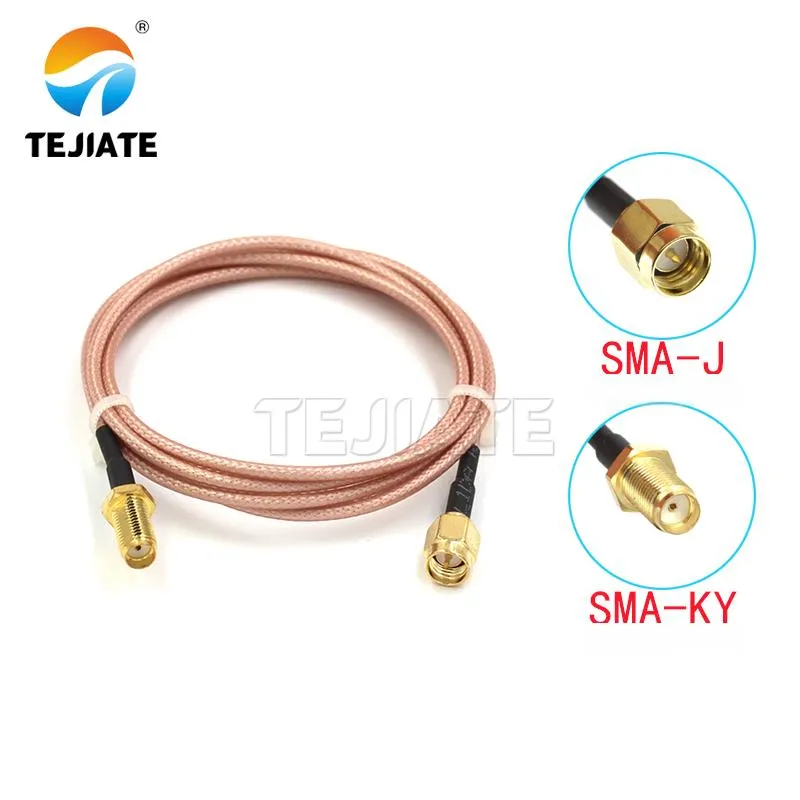
This picture displays a range of SMA connectors, likely labeled with common gender codes (e.g., SMA-J for male, SMA-K for female). It serves as a visual aid to help buyers correctly identify and select the required connector polarity for their SMA extension cables, complementing the document's discussion on the importance of choosing between male-to-female and male-to-male cables for specific applications like routers vs. test benches.
Choosing the right length isn’t just a matter of convenience—it keeps your installation neat and your signal loss predictable. Most buyers find that stocking SMA male to female extension cables in standard lengths such as 10 cm, 30 cm, and 1 m covers 80% of their needs. These options are easy to source and reduce the risk of over-ordering custom runs.
A 10 cm jumper is perfect as a stress reliever at the device jack, especially for routers or handheld radios where antennas otherwise sit directly on fragile connectors. A 30 cm SMA extension provides just enough reach for test setups or small enclosures without creating messy slack. The 1 m option strikes a balance—it can handle wall-mounted antennas or outdoor placements while keeping attenuation at acceptable levels on RG316. Beyond 1–2 m, many engineers recommend moving to LMR-200 SMA cables to keep link budgets safe.
Picks for GPS/Wi-Fi/ham handhelds at common lengths
- GPS antenna cable (SMA): Typically 3–5 m, but even then, adding a 30 cm jumper inside the vehicle avoids torque stress on the head unit.
- Wi-Fi antenna extension cable: Most routers and APs work best with 1–3 m runs. Go longer, and RG316 or RG174 losses will start to show; LMR-200 becomes the smarter option.
- Ham handheld radios: Adding a short SMA male to female extension cable of 10 cm or 30 cm helps reduce strain when connecting to mag-mount or whip antennas.
Pairing internal U.FL→SMA pigtail with exterior SMA extension
How do you weather-proof outdoor runs properly?
IP67 SMA bulkhead stack: O-ring, washer, nut, sealant
Strain relief and drip-loop tips to keep loss stable
Sealing alone isn’t enough. Cables also fail from stress, especially when they’re pulled tight against enclosures. Always route with a gentle bend—never a sharp kink—and use ties that don’t crush the jacket. Adding a drip loop before the connector ensures rainwater drips off instead of flowing straight inside. These little tricks keep your 50 ohm coax cable within spec and avoid return-loss surprises.
For consumer networking gear, outdoor setups often require not just waterproofing but also polarity checks. Many Wi-Fi routers use RP-SMA ports, meaning you’ll need an rp-sma extension cable with IP67 bulkhead fittings to bridge inside and outside connections. Overlooking this detail is one of the most common causes of failed outdoor installs. For broader best practices, TEJTE’s antenna extension cable guide covers proven weatherproofing steps from real deployments.
Can your build pass acceptance before purchase?
Pre-buy checks: thread, polarity, torque, length, bend radius
- Thread size: Verify whether the port requires standard SMA or RP-SMA bulkhead. A mismatch here means the antenna simply won’t connect.
- Polarity: A quick pin check avoids the classic SMA vs RP-SMA mix-up.
- Torque: About 0.6 N·m is recommended—tight enough for stability, but not so much that it damages PCB-mounted jacks.
- Length: At 2 m or longer, attenuation starts to bite. That’s where sma male to female extension cable options built on LMR-200 outperform thinner coax like RG316.
- Bend radius: Respect the minimum—~15 mm for RG316, ~28 mm for RG174. Sharp bends lead to return-loss spikes and early failures.
Below is a structured acceptance checklist that procurement teams can adapt directly into their workflow.
| Use-Case | Band | Target Loss (dB) | Length | Connector Pair | Polarity | Bend Radius | Environment | Result |
|---|---|---|---|---|---|---|---|---|
| Wi-Fi Router | 2.4 GHz | ≤ 2 dB | 1 m | SMA Male–Female | Male-Female | ≥ 28 mm (RG174) | Indoor | Pass |
| GPS Antenna Car | 1.575 GHz | ≤ 3 dB | 3 m | SMA Male–Female | SMA | ≥ 15 mm (RG316) | Semi-outdoor | Pass |
| Ham Radio Base | 430 MHz | ≤ 2 dB | 5 m | SMA Male–Female | SMA | ≥ 25 mm (LMR-200) | Outdoor / IP67 | Revise |
| Test Bench Link | 5.8 GHz | ≤ 1.5 dB | 30 cm | SMA Male–Male | SMA | ≥ 15 mm (RG316) | Indoor | Pass |
- Thread size: Verify whether the port requires standard SMA or RP-SMA bulkhead. A mismatch here means the antenna simply won’t connect.
- Polarity: A quick pin check avoids the classic SMA vs RP-SMA mix-up.
- Torque: About 0.6 N·m is recommended—tight enough for stability, but not so much that it damages PCB-mounted jacks.
- Length: At 2 m or longer, attenuation starts to bite. That’s where sma male to female extension cable options built on LMR-200 outperform thinner coax like RG316.
- Bend radius: Respect the minimum—~15 mm for RG316, ~28 mm for RG174. Sharp bends lead to return-loss spikes and early failures.
Below is a structured acceptance checklist that procurement teams can adapt directly into their workflow.
FAQ: SMA Extension Cable Buyers Ask
How long can an RG316 SMA extension run at 2.4 GHz before loss kills range?
RG316 looks compact, but its loss adds up quickly. At 2.4 GHz, attenuation is about 1.46 dB per meter. That means a 2 m run costs you nearly 3 dB—half your signal power. Beyond 2–3 m, many buyers switch to LMR-200 SMA cables to keep performance stable. More details are covered in TEJTE’s RG316 cable guide.
Should I order SMA male-to-female or male-to-male for routers and APs?
For networking gear, the safe choice is always an SMA male to female extension cable. Routers usually ship with female ports, while antennas are male. Male-to-male styles are rarely used outside of test benches.
When does a right-angle SMA help more than it hurts (extra dB at the elbow)?
Each elbow adds ~0.1–0.2 dB of loss. That sounds minor, but if you’re already close to the limit of your 50 ohm coax cable chain, it could tip the balance. Still, in tight IoT boxes or handheld radios, the mechanical relief is worth it—as long as the elbow has a solid VSWR rating.
What’s the fastest way to avoid an SMA vs RP-SMA polarity mismatch?
Check the center conductor. Pin = SMA male. Hole = RP-SMA male. Reverse this for the female side. It takes seconds and avoids wasted orders. TEJTE’s SMA connector guide shows the difference in photos.
Do I really need an IP67 SMA bulkhead outdoors, and how do I seal it correctly?
Yes. Outdoor moisture is the #1 killer of coax. Use an IP67 bulkhead with O-ring, washer, and nut, then wrap with silicone tape for extra protection. TEJTE’s bulkhead connector guide explains sealing options in detail.
If my link budget is tight, is LMR-200 a better pick than RG316 for 1–5 m?
Absolutely. LMR-200 has almost half the attenuation of RG316, which makes it a better investment for medium runs.
What’s the safe minimum bend radius for RG316 to avoid return-loss spikes?
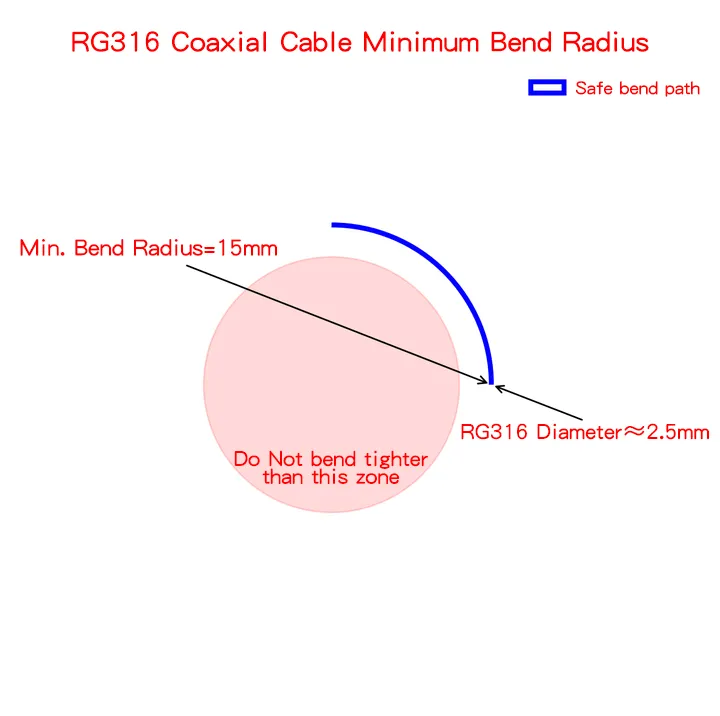
This technical illustration is critical for proper installation. It clearly defines the 15mm minimum bend radius for RG316 cable, warning against bending tighter than this specified zone. The document contextually links this spec to the prevention of impedance shifts, increased VSWR (return loss), and potential physical damage to the cable, which could lead to signal degradation and premature failure. It underscores the importance of respecting mechanical limits during installation.
Bonfon Office Building, Longgang District, Shenzhen City, Guangdong Province, China

A China-based OEM/ODM RF communications supplier
Table of Contents
Owning your OEM/ODM/Private Label for Electronic Devices andComponents is now easier than ever.
